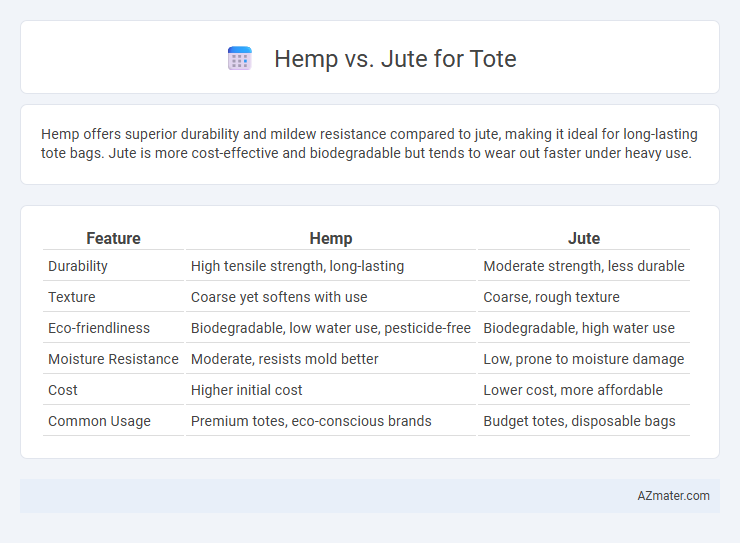Hemp offers superior durability and mildew resistance compared to jute, making it ideal for long-lasting tote bags. Jute is more cost-effective and biodegradable but tends to wear out faster under heavy use.
Table of Comparison
| Feature | Hemp | Jute |
|---|---|---|
| Durability | High tensile strength, long-lasting | Moderate strength, less durable |
| Texture | Coarse yet softens with use | Coarse, rough texture |
| Eco-friendliness | Biodegradable, low water use, pesticide-free | Biodegradable, high water use |
| Moisture Resistance | Moderate, resists mold better | Low, prone to moisture damage |
| Cost | Higher initial cost | Lower cost, more affordable |
| Common Usage | Premium totes, eco-conscious brands | Budget totes, disposable bags |
Introduction: Hemp vs Jute for Tote Bags
Hemp and jute are sustainable fibers frequently compared for tote bag production due to their environmental benefits and durability. Hemp fibers are stronger, more resistant to wear, and naturally antimicrobial, making them ideal for long-lasting tote bags. Jute, known for its affordability and biodegradable properties, offers a coarse texture that appeals to eco-conscious consumers seeking budget-friendly, biodegradable totes.
Origins and Cultivation of Hemp and Jute
Hemp, originating from Central Asia, thrives in temperate climates with minimal pesticides due to its natural pest resistance, making it an eco-friendly fiber choice for tote bags. Jute, primarily cultivated in the Indian subcontinent, requires a humid, warm climate and abundant rainfall, favoring river basin regions for optimal growth. Both fibers are harvested seasonally, with hemp offering faster growth cycles of 3-4 months compared to jute's 4-6 months, influencing their sustainability profiles for tote manufacturing.
Environmental Impact: Hemp vs Jute
Hemp cultivation requires significantly less water and pesticides compared to jute, making it a more sustainable choice for tote production. Hemp plants grow faster, absorb more CO2 per acre, and improve soil health through phytoremediation. Jute, however, benefits from its biodegradability and shorter retting process, but its higher water consumption and pesticide use contribute to a larger environmental footprint.
Durability and Strength Comparison
Hemp fibers exhibit exceptional durability and tensile strength, making them ideal for heavy-duty tote bags that withstand extended use and significant weight. Jute, while economically efficient and biodegradable, offers moderate tensile strength and tends to degrade faster under stress and moisture exposure. The higher lignin content in hemp contributes to superior resistance against wear and tear, enhancing the longevity of hemp totes compared to jute counterparts.
Texture and Aesthetic Appeal
Hemp tote bags feature a coarse texture with a natural, rugged aesthetic that appeals to those seeking durability and a rustic look. Jute totes offer a rougher, fibrous texture that provides a distinctly earthy and organic appearance, often favored for vintage or artisanal designs. The natural sheen of hemp contrasts with the matte finish of jute, influencing the overall visual appeal and tactile experience of each fabric.
Cost Effectiveness and Market Price
Hemp tote bags generally have a higher initial cost due to the durability and sustainability of hemp fibers but offer better long-term value because of their strength and longevity. Jute tote bags, while cheaper upfront, tend to wear out faster, leading to higher replacement costs over time. Market prices for hemp totes range from $5 to $15 per unit, compared to $2 to $8 for jute, making hemp more cost-effective for eco-conscious consumers seeking durability.
Biodegradability and Sustainability
Hemp fibers exhibit superior biodegradability compared to jute, breaking down more rapidly in natural environments without releasing harmful residues. Sustainability metrics favor hemp due to its faster growth cycle, lower water requirements, and higher carbon sequestration capacity. Both fibers offer eco-friendly alternatives for tote bags, but hemp's environmental impact profile aligns more closely with circular economy principles.
Versatility in Tote Bag Designs
Hemp offers exceptional versatility in tote bag designs due to its strong, durable fibers that allow for a wide range of textures and finishes, from coarse to smooth. Jute, known for its natural luster and stiffness, lends itself well to structured tote bags with rustic, eco-friendly appeal, but is less flexible for intricate designs. Combining hemp's adaptability with jute's sturdy texture can create innovative tote bags that balance durability, aesthetics, and eco-consciousness.
Consumer Preferences and Trends
Consumers prefer hemp over jute for tote bags due to its superior durability, eco-friendliness, and softer texture, which enhances carrying comfort. Market trends indicate a growing demand for sustainable and biodegradable materials, positioning hemp as the favored choice in the eco-conscious segment. Research shows that hemp totes offer longer lifespan and resistance to wear, aligning with consumer preferences for quality and environmental impact.
Conclusion: Which Material Wins for Totes?
Hemp outperforms jute for tote bags due to its superior durability, natural resistance to mold, and eco-friendly cultivation requiring less water and pesticides. The long fibers of hemp create stronger, more resilient fabric ideal for heavy-duty use while maintaining biodegradability and sustainability. Jute remains a cost-effective alternative, but hemp's overall environmental benefits and material strength make it the preferred choice for high-quality, sustainable totes.

Infographic: Hemp vs Jute for Tote
 azmater.com
azmater.com